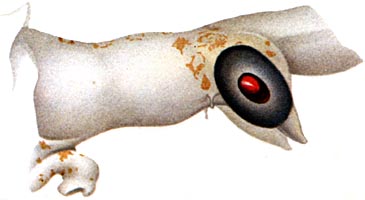Planctoteuthis exopthalmica
Richard E. Young and Clyde F. E. RoperIntroduction
P. exopthalmica is poorly known as the original description was based on a 25 mm and a 9.5 mm ML paralarva. The 9.5 mm ML specimen, taken from the Indian Ocean, was designated as the lectotype (i.e., a "holotype" designated from the original type series) by Glaubrecht and Salcedo-Vargas (2000:274). The 25 mm ML specimen, taken in the North Atlantic, has been placed in the synonomy of P. levimana by Young et al. (2006). The most distinguishing feature of the small lectotype is a slender, unexpanded club, a feature shared with P. levimana. P. exopthalmica may eventually prove to be a junior synonym of P. levimana.
Characteristics
From Chun, 1910:- Arms
- Arms IV bear uniserial suckers.
- Arms IV 7 mm long.
- Tentacular clubs
- Club not expanded
- Low, thick protective membranes along dorsal and ventral borders.
- Head
- Head and neck 8 mm to base of arms.
- Oblong cone laterally carries strongly protruding eyes.
- Eyes with very long ventral process.
- Fins
- Dorsal base of fins short (1.5 mm).
- Combined width of fins 3.8 mm.
Comments
Most of Chun's description was based on the larger specimen which no longer is placed in this species. Chun states, "The smaller specimen from the Indian Ocean closely resembles the [larger] specimen in all important characters." However, we reproduce here only information specifically based on the small lectotype.
Nomenclature
This species was originally described by by Chun (1908) as Doratopsis exopthalmica and was placed in Planktoteuthis by Young (1991) due to the characteristic ventrally protruding eyes and shape of the fins.
Distribution
Geographical distribution
The lectotype is from the temperate South Indian Ocean at 43° 13'S, 80° 30'E.
References
Chun, C. 1908. Ueber Cephalopoden der Deutschen Tiefsee-Expedition, Zoologischer Anzeiger, 33: 86-89.
Chun, C. 1910. Die Cephalopoden. Oegopsida. Wissenschaftliche Ergebnisse der Deutschen Tiefsee-Expedition, "Valdivia" 1898-1899, 18: 1-522 , Atlas.
Glaubrecht, M. and M.A. Salcedo-Vargas. 2000. Annotated type catalogue of the Cephalopoda (Mollusca) in the Museum fur Naturkunde, Humboldt University of Berlin. Mitteilungen aus dem Museum fur Naturkunde Berlin, Zoologischen, 76(2):269-282.
Pfeffer, G. 1912. Die Cephalopoden der Plankton-Expedition. Ergebniss der Plankton-Expedition der Humboldt-Stiftung. 2: 1-815.
Young, R. E., M. Vecchione, U. Piatkowski and C. F. E. Roper. In press. A redescription of Planctoteuthis levimana (Lonnberg, 1896) (Mollusca; Cephalopoda), with a brief review of the genus. 2006. Proc. Biol. Soc. Washington, 119 (4): 586-591.
Title Illustrations

| Scientific Name | Planctoteuthis exopthalmica |
|---|---|
| Reference | Chun, C. 1910. Die Cephalopoden. Oegopsida. Wissenschaftliche Ergebnisse der Deutschen Tiefsee-Expedition, "Valdivia" 1898-1899, 18: 1-522 + Atlas. |
| Size | 9.5 mm ML |
About This Page

University of Hawaii, Honolulu, HI, USA

Smithsonian Institution, Washington, D. C., USA
Page copyright © 2016 and
 Page: Tree of Life
Planctoteuthis exopthalmica .
Authored by
Richard E. Young and Clyde F. E. Roper.
The TEXT of this page is licensed under the
Creative Commons Attribution-NonCommercial License - Version 3.0. Note that images and other media
featured on this page are each governed by their own license, and they may or may not be available
for reuse. Click on an image or a media link to access the media data window, which provides the
relevant licensing information. For the general terms and conditions of ToL material reuse and
redistribution, please see the Tree of Life Copyright
Policies.
Page: Tree of Life
Planctoteuthis exopthalmica .
Authored by
Richard E. Young and Clyde F. E. Roper.
The TEXT of this page is licensed under the
Creative Commons Attribution-NonCommercial License - Version 3.0. Note that images and other media
featured on this page are each governed by their own license, and they may or may not be available
for reuse. Click on an image or a media link to access the media data window, which provides the
relevant licensing information. For the general terms and conditions of ToL material reuse and
redistribution, please see the Tree of Life Copyright
Policies.
- Content changed 29 August 2016
Citing this page:
Young, Richard E. and Clyde F. E. Roper. 2016. Planctoteuthis exopthalmica . Version 29 August 2016 (under construction). http://tolweb.org/Planctoteuthis_exopthalmica/19493/2016.08.29 in The Tree of Life Web Project, http://tolweb.org/











 Go to quick links
Go to quick search
Go to navigation for this section of the ToL site
Go to detailed links for the ToL site
Go to quick links
Go to quick search
Go to navigation for this section of the ToL site
Go to detailed links for the ToL site